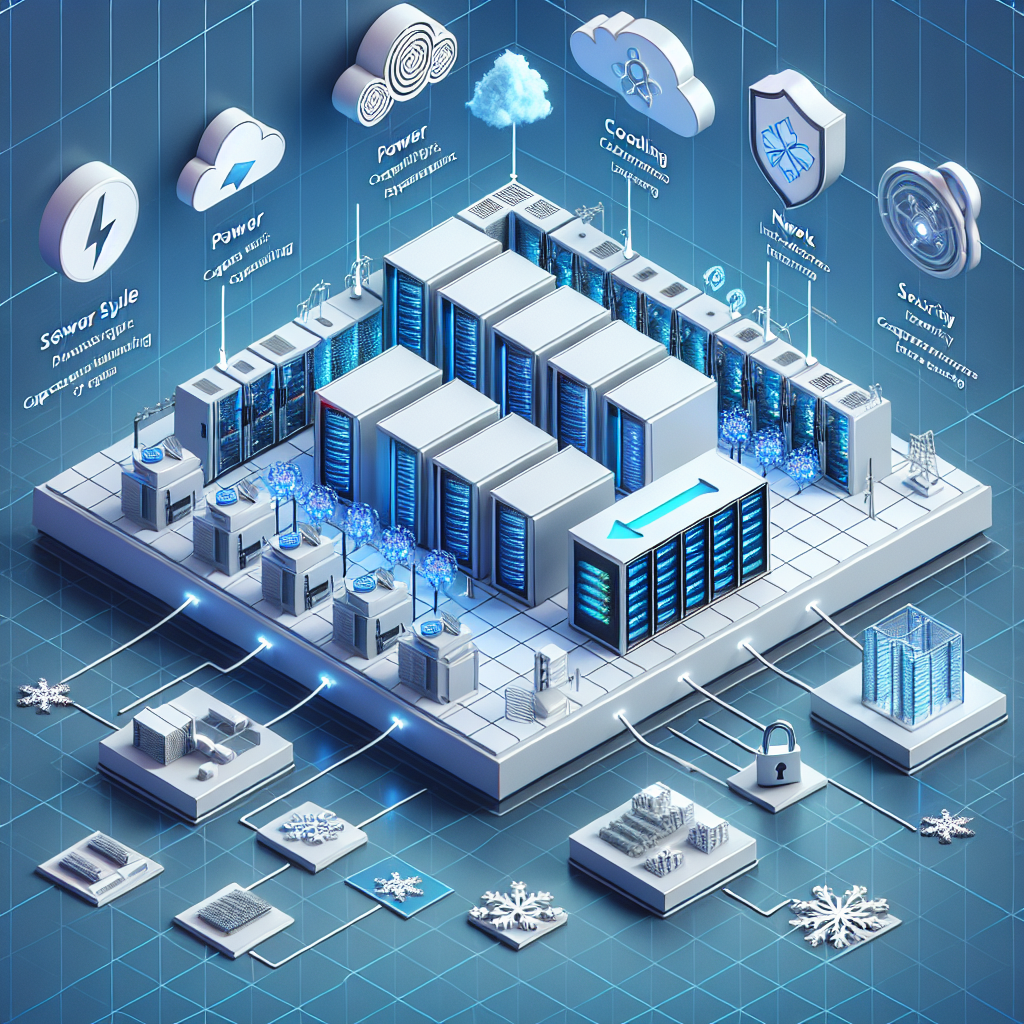Your cart is currently empty!
Tag: Capacity

The Future of Data Center Capacity Planning: Emerging Technologies and Strategies
As data centers continue to play a crucial role in the digital economy, the need for effective capacity planning has become more important than ever. With the increasing demand for data storage and processing power, data center operators are constantly looking for innovative technologies and strategies to optimize their capacity planning processes.One of the key challenges in data center capacity planning is the unpredictability of data growth. With the rise of big data, IoT devices, and cloud computing, data centers are faced with the daunting task of ensuring that they have enough capacity to handle the ever-increasing volume of data. Traditional capacity planning methods, such as using historical data and linear projections, are no longer sufficient to accurately forecast future capacity requirements.
To address this challenge, data center operators are turning to emerging technologies such as artificial intelligence (AI) and machine learning (ML) to improve their capacity planning processes. By analyzing large volumes of data in real-time, AI and ML algorithms can help predict future capacity requirements more accurately and identify potential bottlenecks before they occur. This proactive approach allows data center operators to make informed decisions about when and where to invest in additional capacity, helping them to avoid costly downtime and improve overall efficiency.
In addition to AI and ML, data center operators are also exploring new strategies to optimize their capacity planning processes. For example, some companies are adopting a modular approach to data center design, which allows them to quickly scale their capacity up or down based on demand. By using pre-fabricated modules that can be easily added or removed as needed, data center operators can adapt to changing capacity requirements more efficiently and cost-effectively.
Another emerging trend in data center capacity planning is the use of predictive analytics to forecast capacity requirements. By analyzing historical data and trends, data center operators can identify patterns and anomalies that may indicate future capacity needs. This proactive approach allows them to anticipate capacity issues before they arise and take preemptive action to prevent downtime.
Overall, the future of data center capacity planning looks promising, with emerging technologies and strategies offering new opportunities to optimize capacity management and improve overall efficiency. By leveraging AI, ML, and predictive analytics, data center operators can make more informed decisions about their capacity requirements and ensure that they are able to meet the growing demands of the digital economy. As data centers continue to evolve, it is clear that effective capacity planning will be a key factor in their success.

Challenges and Solutions in Data Center Capacity Planning
Data center capacity planning is a critical aspect of managing a data center effectively. With the increasing amount of data being generated and stored every day, data centers need to constantly adapt and scale their infrastructure to meet the growing demands of users and applications. However, this comes with its own set of challenges that need to be addressed in order to ensure smooth operations and optimal performance.One of the main challenges in data center capacity planning is predicting future growth and capacity requirements. It can be difficult to accurately forecast how much storage, computing power, and networking resources will be needed in the coming months or years. This uncertainty can lead to either under-provisioning, which can result in performance issues and downtime, or over-provisioning, which can lead to wasted resources and increased costs.
Another challenge is ensuring that the data center infrastructure is flexible and scalable enough to accommodate changes in demand and technology. As new applications and technologies emerge, data centers need to be able to quickly adapt and scale their resources accordingly. This can be particularly challenging in legacy data centers that may have outdated or inflexible infrastructure.
In addition, data center capacity planning also needs to take into account factors such as energy efficiency, cooling requirements, and physical space constraints. As data centers continue to grow in size and complexity, they consume more power and generate more heat, which can lead to increased cooling costs and environmental impact. Finding ways to improve energy efficiency and optimize cooling systems is crucial for managing data center capacity effectively.
So, what are some solutions to these challenges in data center capacity planning?
One solution is to leverage data analytics and monitoring tools to collect and analyze data on resource usage, performance metrics, and trends. By using this data, data center managers can gain insights into current usage patterns and make more informed decisions about capacity planning.
Another solution is to adopt a modular and scalable infrastructure design that allows for easy expansion and contraction of resources as needed. This can involve using technologies such as virtualization, software-defined networking, and cloud computing to dynamically allocate resources based on demand.
Furthermore, implementing best practices for energy efficiency, such as using high-efficiency cooling systems, optimizing server utilization, and consolidating hardware, can help reduce energy consumption and lower operating costs.
Overall, data center capacity planning is a complex and ongoing process that requires careful planning, monitoring, and optimization. By addressing the challenges and implementing the right solutions, data center managers can ensure that their infrastructure is able to meet the demands of today and tomorrow.

Planning for Growth: Scaling Your Data Center with Capacity Planning
As businesses grow and expand, so too does the need for a robust and efficient data center. With the increasing reliance on data and technology in today’s world, it is more important than ever for organizations to adequately plan for the growth of their data center infrastructure. Capacity planning is a crucial aspect of this process, as it involves forecasting future demand and ensuring that the data center has the necessary resources to meet those requirements.Capacity planning involves assessing the current capacity of the data center, predicting future growth and demand, and making informed decisions about how to scale the infrastructure to accommodate this growth. By taking a proactive approach to capacity planning, organizations can avoid potential bottlenecks and downtime, optimize performance, and ensure that the data center remains efficient and cost-effective.
One key aspect of capacity planning is understanding the current utilization of resources within the data center. By monitoring key metrics such as CPU usage, memory usage, storage capacity, and network bandwidth, organizations can gain valuable insights into how resources are being utilized and identify potential areas for optimization. This information can then be used to forecast future demand and determine the necessary capacity requirements to support this growth.
Another important consideration in capacity planning is scalability. Organizations should design their data center infrastructure with scalability in mind, so that it can easily accommodate future growth without the need for extensive redesign or costly upgrades. This may involve implementing modular or scalable hardware solutions, virtualization technologies, and cloud services that can be easily scaled up or down as needed.
In addition to technical considerations, capacity planning also involves aligning the data center infrastructure with the organization’s business goals and objectives. By working closely with key stakeholders and understanding the organization’s future plans and growth projections, IT teams can develop a capacity plan that is closely aligned with the needs of the business.
Ultimately, capacity planning is an ongoing process that requires regular monitoring and adjustment to ensure that the data center remains in line with the organization’s evolving needs. By taking a proactive approach to capacity planning and investing in scalable and flexible infrastructure solutions, organizations can position themselves for growth and ensure that their data center remains a strategic asset that supports the success of the business.

How Data Center Capacity Planning Impacts IT Infrastructure Management
Data center capacity planning is a crucial aspect of IT infrastructure management that has a significant impact on the overall performance and efficiency of an organization’s IT systems. Capacity planning involves predicting future demand for computing resources, such as storage, processing power, and network bandwidth, and ensuring that the data center has the necessary capacity to meet these demands.Effective capacity planning is essential for ensuring that the data center can support the organization’s current and future IT needs without incurring unnecessary costs or risks. If capacity planning is not done properly, organizations may experience performance issues, downtime, and increased operational costs.
One of the key ways in which data center capacity planning impacts IT infrastructure management is by helping organizations optimize resource utilization. By accurately forecasting future demand for computing resources, organizations can ensure that they have the right amount of capacity in place to meet that demand without over-provisioning or under-provisioning resources. Over-provisioning can lead to wasted resources and increased costs, while under-provisioning can result in performance issues and downtime.
Capacity planning also plays a critical role in ensuring the reliability and availability of IT systems. By proactively assessing capacity needs and planning for future growth, organizations can avoid unexpected outages and downtime that can result from resource constraints. This is especially important for mission-critical applications and services that require high levels of availability.
Additionally, data center capacity planning can help organizations make informed decisions about infrastructure investments and upgrades. By understanding their current and future capacity needs, organizations can prioritize investments in new hardware, software, and infrastructure upgrades to support their growth and business objectives. This can help organizations avoid unnecessary spending on resources that are not needed, while also ensuring that they have the capacity to support their future growth.
In conclusion, data center capacity planning is a critical component of IT infrastructure management that can have a significant impact on the performance, reliability, and efficiency of an organization’s IT systems. By accurately forecasting future demand for computing resources and planning for future growth, organizations can optimize resource utilization, ensure reliability and availability, and make informed decisions about infrastructure investments. Effective capacity planning is essential for organizations looking to maximize the value of their IT investments and support their business objectives.

Trends and Best Practices in Data Center Capacity Planning
Data centers are the backbone of any organization’s IT infrastructure, providing the necessary computing power, storage, and networking capabilities to support business operations. With the increasing volume of data being generated and processed by businesses, data center capacity planning has become a critical aspect of IT management. In this article, we will discuss the latest trends and best practices in data center capacity planning to help organizations optimize their data center resources and ensure smooth operations.Trends in Data Center Capacity Planning
1. Hybrid and Multi-Cloud Environments: Many organizations are adopting hybrid and multi-cloud strategies to leverage the benefits of both on-premises and cloud-based solutions. This trend has implications for data center capacity planning, as organizations need to assess their current and future workload requirements to determine the optimal mix of on-premises and cloud resources.
2. Edge Computing: The proliferation of Internet of Things (IoT) devices and the need for real-time data processing have led to the rise of edge computing. Edge data centers are deployed closer to the point of data generation, reducing latency and improving performance. Data center capacity planning for edge computing requires a different approach, as organizations need to consider factors such as power and cooling requirements, network connectivity, and security.
3. Software-Defined Infrastructure: Software-defined infrastructure technologies, such as virtualization and containerization, are changing the way data centers are managed and provisioned. These technologies enable organizations to dynamically allocate resources based on workload demands, leading to more efficient use of data center resources. Data center capacity planning in a software-defined environment requires a holistic view of the infrastructure and the ability to scale resources up or down as needed.
Best Practices in Data Center Capacity Planning
1. Conduct Regular Capacity Assessments: To ensure that data center resources are aligned with business requirements, organizations should conduct regular capacity assessments to identify potential bottlenecks and areas of inefficiency. By analyzing historical data and forecasting future workload demands, organizations can proactively plan for capacity upgrades or optimizations.
2. Implement Resource Monitoring and Management Tools: Monitoring tools can provide real-time insights into data center performance and resource utilization, enabling organizations to identify underutilized resources or potential capacity constraints. By implementing automated resource management tools, organizations can optimize resource allocation and improve overall data center efficiency.
3. Plan for Scalability and Flexibility: When designing a data center capacity plan, organizations should consider scalability and flexibility to accommodate future growth and changes in workload requirements. Building a modular and flexible infrastructure allows organizations to easily scale resources up or down as needed, without disrupting operations.
4. Consider Energy Efficiency: With the rising costs of energy and concerns about environmental sustainability, organizations should prioritize energy efficiency in their data center capacity planning efforts. By adopting energy-efficient technologies, such as virtualization, cooling optimization, and energy management tools, organizations can reduce their carbon footprint and lower operating costs.
In conclusion, data center capacity planning is a complex and critical process that requires careful consideration of current and future workload requirements, as well as the latest trends and best practices in the industry. By leveraging the latest technologies and adopting best practices, organizations can optimize their data center resources, improve performance, and ensure the smooth operation of their IT infrastructure.

Maximizing Data Center Efficiency through Capacity Planning
Data centers are the backbone of modern technology, housing the servers and hardware that power everything from social media platforms to financial transactions. As the demand for data storage and processing continues to grow, it is essential for data center operators to maximize efficiency through effective capacity planning.Capacity planning is the process of determining the optimal amount of resources needed to support the current and future needs of a data center. By accurately forecasting demand and strategically allocating resources, data center operators can ensure that their facilities are operating at peak efficiency while minimizing costs.
One key aspect of capacity planning is understanding the workload demands of the data center. By analyzing historical data and trends, operators can predict how much processing power, storage, and network bandwidth will be needed to support current and future workloads. This information can then be used to determine the optimal hardware configurations and resource allocations for the data center.
Another important factor in capacity planning is ensuring that the data center is not over-provisioned or under-provisioned. Over-provisioning can lead to wasted resources and increased operating costs, while under-provisioning can result in performance bottlenecks and downtime. By carefully balancing resource allocation with actual demand, data center operators can maximize efficiency and ensure that their facilities are operating at optimal levels.
In addition to hardware resources, capacity planning also involves optimizing the layout and design of the data center. By strategically positioning servers, cooling systems, and networking equipment, operators can reduce energy consumption, improve airflow, and enhance overall efficiency. This can lead to significant cost savings and improved performance for the data center.
Furthermore, data center operators can also leverage virtualization and cloud computing technologies to further enhance efficiency and scalability. By virtualizing servers and storage resources, operators can consolidate workloads, improve resource utilization, and reduce hardware costs. Cloud computing, on the other hand, allows operators to offload certain workloads to cloud service providers, reducing the strain on in-house infrastructure and enabling greater flexibility and scalability.
In conclusion, maximizing data center efficiency through capacity planning is essential for ensuring that data centers can meet the growing demands of modern technology. By accurately forecasting demand, optimizing resource allocation, and leveraging virtualization and cloud computing technologies, data center operators can maximize efficiency, reduce costs, and improve overall performance. By taking a proactive approach to capacity planning, data center operators can future-proof their facilities and ensure that they remain competitive in today’s fast-paced digital landscape.

Key Considerations for Successful Data Center Capacity Planning
Data centers are the backbone of any organization’s IT infrastructure, serving as the hub for storing, processing, and managing data. With the increasing reliance on digital technologies and the exponential growth of data, proper capacity planning for data centers has become essential to ensure optimal performance and efficiency.Successful data center capacity planning requires careful consideration of various factors to meet the organization’s current and future needs. Here are some key considerations to keep in mind when planning for data center capacity:
1. Understand your current and future needs: The first step in capacity planning is to assess your organization’s current data center requirements and anticipate future growth. Consider factors such as the volume of data being generated, the number of users accessing the system, and the types of applications running on the infrastructure.
2. Evaluate existing infrastructure: Before planning for additional capacity, it’s important to evaluate the efficiency of your existing data center infrastructure. Assess the utilization rates of servers, storage, and networking equipment to identify any bottlenecks or areas of improvement.
3. Consider scalability: When planning for data center capacity, it’s crucial to consider scalability. Choose infrastructure solutions that can easily scale up or down based on your organization’s changing needs. This will help avoid over-provisioning or under-provisioning resources, ensuring optimal performance and cost-efficiency.
4. Plan for redundancy: Redundancy is essential for ensuring high availability and minimizing the risk of downtime. Implementing redundant power supplies, cooling systems, and network connections can help mitigate the impact of hardware failures or maintenance activities.
5. Embrace virtualization and cloud technologies: Virtualization and cloud technologies can help optimize data center capacity by consolidating workloads and enabling flexible resource allocation. Consider adopting these technologies to maximize efficiency and reduce hardware and operational costs.
6. Implement monitoring and management tools: To effectively manage data center capacity, invest in monitoring and management tools that provide real-time visibility into resource utilization, performance metrics, and potential bottlenecks. These tools can help identify issues proactively and make informed decisions about capacity planning.
7. Plan for future growth: Data centers are not static environments – they need to evolve to accommodate the organization’s growing data and workload requirements. When planning for capacity, consider future growth projections and build in flexibility to scale resources as needed.
In conclusion, successful data center capacity planning requires a holistic approach that considers current and future needs, evaluates existing infrastructure, embraces scalability and redundancy, leverages virtualization and cloud technologies, and implements monitoring and management tools. By carefully considering these key factors, organizations can ensure their data centers are equipped to meet the demands of today’s digital world and support business growth and innovation.

Strategies for Efficient Data Center Capacity Planning
Data centers are the backbone of any organization’s IT infrastructure, housing the servers, storage, and networking equipment that support critical business operations. With the increasing demand for digital services and the rapid growth of data, it is essential for data center managers to efficiently plan and manage their capacity to ensure optimal performance and scalability.Effective data center capacity planning involves forecasting future requirements, optimizing resource utilization, and implementing strategies to accommodate growth and changes in technology. Here are some key strategies for efficient data center capacity planning:
1. Conduct a thorough assessment: The first step in capacity planning is to assess the current state of the data center, including the existing infrastructure, workloads, and performance metrics. By understanding the current utilization levels and performance bottlenecks, data center managers can identify areas for improvement and plan for future capacity requirements.
2. Forecast future requirements: To effectively plan for future capacity needs, data center managers must consider factors such as business growth, application requirements, and technology trends. By analyzing historical data and trends, organizations can make informed decisions about the resources needed to support future workloads and applications.
3. Implement monitoring and reporting tools: Monitoring tools can provide real-time visibility into the performance and utilization of data center resources, allowing managers to identify and address capacity issues before they impact operations. By leveraging reporting tools, organizations can generate insights and trends that can inform capacity planning decisions.
4. Embrace virtualization and cloud computing: Virtualization and cloud computing technologies can help organizations optimize resource utilization and improve scalability. By consolidating workloads onto virtual servers and leveraging cloud resources, data center managers can increase efficiency and flexibility while reducing costs.
5. Adopt a modular approach: Modular data center designs allow organizations to scale their infrastructure in a flexible and cost-effective manner. By deploying modular units that can be easily added or removed as needed, organizations can quickly adapt to changing capacity requirements without the need for major infrastructure upgrades.
6. Consider energy efficiency: Energy costs are a significant expense for data centers, so it is important to consider energy efficiency when planning capacity. By implementing energy-efficient technologies, such as server consolidation, cooling optimization, and power management, organizations can reduce their environmental footprint and save on operating costs.
In conclusion, efficient data center capacity planning is essential for organizations to meet the growing demands of digital services and ensure optimal performance and scalability. By conducting a thorough assessment, forecasting future requirements, implementing monitoring tools, embracing virtualization and cloud computing, adopting a modular approach, and considering energy efficiency, organizations can optimize their data center capacity and support their business objectives effectively.

The Importance of Data Center Capacity Planning in the Digital Age
In today’s digital age, data centers play a crucial role in enabling businesses to store, manage, and process vast amounts of data. With the exponential growth of data being generated every day, it is more important than ever for organizations to have effective capacity planning strategies in place to ensure that their data centers can meet the growing demands of their operations.Data center capacity planning involves anticipating future needs for storage, computing power, and networking resources, and designing the infrastructure to accommodate those needs. It is a critical process that helps organizations optimize their data center resources, minimize downtime, and ensure seamless operations.
One of the key reasons why data center capacity planning is so important in the digital age is the rapid pace at which data is being generated and consumed. With the rise of technologies such as cloud computing, big data analytics, and the Internet of Things (IoT), organizations are collecting and processing more data than ever before. Without proper capacity planning, data centers can quickly become overwhelmed and unable to keep up with the demands placed on them.
In addition, data center capacity planning helps organizations to manage costs effectively. By accurately forecasting their future needs and scaling their infrastructure accordingly, businesses can avoid over-provisioning resources and wasting money on unnecessary hardware and software. Conversely, inadequate capacity planning can lead to under-provisioning, resulting in performance issues, downtime, and lost revenue.
Furthermore, data center capacity planning is essential for ensuring business continuity and disaster recovery. By having the right amount of resources in place, organizations can maintain high levels of availability and reliability, even in the face of unexpected events such as natural disasters or cyber attacks. Without proper planning, data centers may struggle to recover from disruptions and resume operations in a timely manner.
Overall, data center capacity planning is a critical process that organizations cannot afford to overlook in the digital age. By accurately forecasting their future needs, optimizing their infrastructure, and ensuring business continuity, businesses can maximize the efficiency and reliability of their data centers and stay ahead of the curve in an increasingly data-driven world.

Balancing Cost and Performance in Data Center Capacity Planning
Data center capacity planning is a critical aspect of managing and optimizing the performance of a data center. Balancing cost and performance is a key consideration when determining how much capacity is needed and how to allocate resources effectively.One of the main challenges in data center capacity planning is finding the right balance between cost and performance. On one hand, data center managers want to ensure that the data center has enough capacity to meet the demands of the business and its users. This means having enough servers, storage, and networking resources to handle peak loads and ensure that applications run smoothly.
On the other hand, data center managers also need to be mindful of costs. Data center infrastructure can be expensive, and overprovisioning can lead to wasted resources and unnecessary expenses. Finding the right balance between capacity and cost is crucial for optimizing the efficiency and effectiveness of the data center.
There are several strategies that can help data center managers balance cost and performance in capacity planning. One approach is to conduct regular capacity assessments to understand current usage and trends. By monitoring resource utilization and performance metrics, data center managers can identify areas where capacity may be underutilized or overprovisioned.
Another strategy is to prioritize workloads based on their importance and resource requirements. By categorizing applications and services based on their criticality and performance needs, data center managers can allocate resources more effectively and ensure that key workloads receive the necessary capacity.
Additionally, data center managers can consider implementing technologies such as virtualization and cloud computing to optimize resource utilization and reduce costs. Virtualization allows multiple virtual machines to run on a single physical server, which can help to maximize resource efficiency and reduce the need for additional hardware.
Cloud computing offers a flexible and scalable approach to capacity planning, allowing organizations to scale up or down based on demand. By leveraging cloud services, data center managers can avoid overprovisioning and only pay for the resources they actually use.
In conclusion, balancing cost and performance in data center capacity planning is essential for optimizing the efficiency and effectiveness of the data center. By conducting regular capacity assessments, prioritizing workloads, and leveraging technologies such as virtualization and cloud computing, data center managers can find the right balance between capacity and cost to meet the needs of the business and its users.
